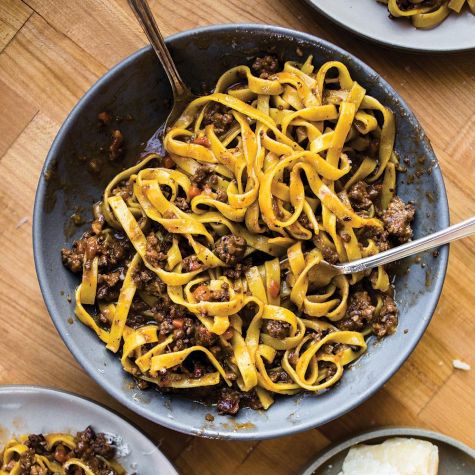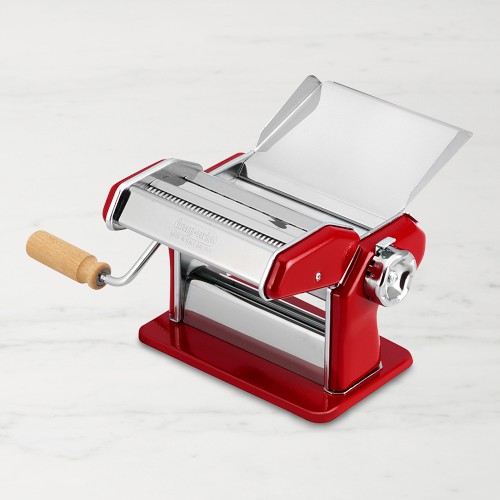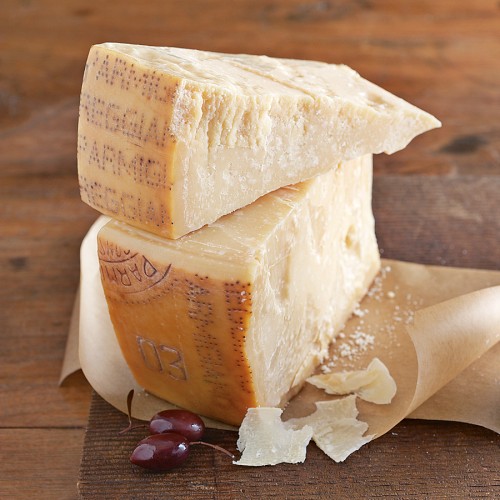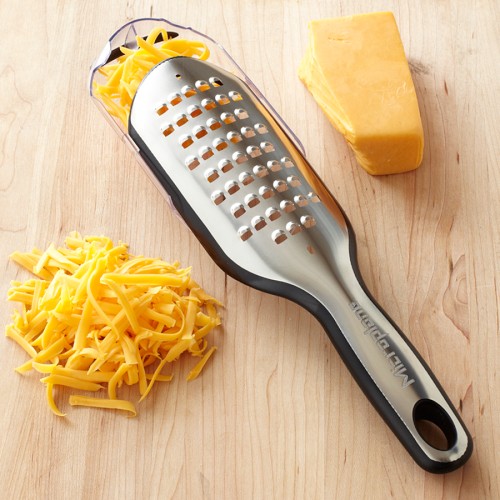
Tagliatelle Bolognese
Chef Thomas McNaughton, chef and owner of the San Francisco restaurant Flour + Water, adapted this recipe from one used at Bruno e Franco la Salumeria, where he worked in Bologna, Italy. A good Bolognese, he says, is all about the melding of flavors, neither too dry nor too wet. When you twirl your noodles together, there should be just enough sauce to bind the noodles together. The meat and tomato flavors come together through the addition of milk, which acts as the sauce’s binding agent. The most important ingredient in Bolognese is time, which turns the ingredients into something greater than the sum of its parts.
Ingredients:
- Semolina flour for dusting
- 1 batch Egg Pasta Dough
For the Bolognese ragu:
- 2 Tbs. extra-virgin olive oil
- 1 onion, finely chopped
- 1 celery stalk, finely chopped
- 1 carrot, finely chopped
- 12 oz. (375 g) ground beef
- 5 1/2 oz. (170 g) ground pork
- 3 1/2 oz. (100 g) pancetta, chopped
- 3 cups (750 ml) chicken stock
- 2 Tbs. tomato paste
- 1 cup (250 ml) milk
- Kosher salt and freshly ground pepper, to taste
To finish:
- 8 Tbs. (1 stick) (4 oz./125 g) unsalted butter
- Kosher salt, to taste
- Freshly grated Parmigiano-Reggiano cheese for finishing
Directions:
Dust 2 baking sheets with semolina flour and set aside.
Prepare the pasta dough as instructed (see related recipe at left). Let rest for at least 30 minutes at room temperature. If resting for more than 6 hours, store the dough in the refrigerator. The dough will hold for up 2 days in the refrigerator, but it’s best to use it the same day you make it, because the egg yolks will oxidize and discolor the dough over time. Remove the dough from the refrigerator at least 30 minutes before rolling it out.
To make the tagliatelle, slice off a section of the ball of dough, immediately rewrapping the unused portion in plastic wrap. Place the piece of dough on the work surface and, with a rolling pin, flatten it enough so that it will fit into the widest setting of your pasta machine. Begin rolling the dough through the machine, starting with the widest setting. Guide it quickly through the slot once. Then decrease the thickness setting by one and repeat. Decrease the thickness setting by one more and roll the dough through quickly one more time. Once the dough has gone through three times, once of each of the first three settings, it should have doubled in length.
Lay the dough on a flat surface. The dough’s hydration level at this point is so low that you’ll probably see some streaks; this is normal, which is the reason for the next crucial step: laminating the dough.
Using a rolling pin as a makeshift ruler, measure the width of your pasta machine’s slot, minus the thickness of two fingers. This measurement represents the ideal width of the pasta sheet, with about a finger’s length on each side, so there’s plenty of room in the machine. Take that rolling pin measurement to the end of the pasta sheet and make a gentle indentation in the dough representing the measurement’s length. Make that mark the crease and fold the pasta over. Repeat for the rest of the pasta sheet, keeping that same initial measurement. For best results, you want a minimum of four layers. Secure the layers of the pasta together with the rolling pin, rolling it flat enough that it can fit in the machine. Put the dough back in the machine, but with a 90-degree turn of the sheet. In other words, what was the bottom edge of the pasta is now going through the machine first.
This time around it’s important to roll out the dough to three times on each setting at a steady, smooth pace. If you roll it too fast, it will snap back to its earlier thickness, thereby lengthening the time you’re going through each number.
It’s important to maintain a consistent speed while cranking in order to keep a consistent thickness. You should be able to see and feel the resistance as the dough passes through the rollers. On the first time at each level, the dough will compress. It’s time to move onto the next level with the dough slips through without any trouble. The first few thickness settings (the biggest widths) usually require three passes; once you’re into thinner territory, there’s less pasta dough compressing, so it goes more quickly and two passes get the job done.
Keep rolling the dough until it is just translucent, or just slightly thinner than 1/16 inch (2 mm). If you can see the outline of your fingers behind it, or the grain of the wood table through the pasta, you’re in good shape. For most (but not all) hand-cranked pasta machines at home, it’s the second-to-last setting.
With a knife, cut the dough into 12-inch (30-cm) strips. Make two stacks of strips, four strips per stack, thoroughly dusting between the layers with semolina flour. Allow the dough to dry for 30 to 45 minutes, or until the dough has a slightly dry, leathery texture but is still pliable. Fold each stack like a letter, forming three even layers. Cut the folded dough into 1/4-inch (6-mm) strips, shake off the excess semolina, and form into small nests on the prepared baking sheets. Set aside.
To make the ragu, in a large, heavy pot over medium-high heat, warm the oil. Add the onion, celery and carrot. Sauté until soft, 8 to 10 minutes. Add the beef, pork and pancetta; sauté, breaking up with a spoon, until browned, about 15 minutes. Add 2 1/2 cups (20 fl. oz./625 ml) of the stock and the tomato paste; stir to blend. Reduce the heat to very low and gently simmer, stirring occasionally, about 2 hours. Season with salt and pepper.
Bring the milk to a simmer in a small saucepan; gradually add to the sauce. Cover the sauce with a lid slightly ajar and simmer over low heat, stirring occasionally, until the milk is absorbed, about 1 hour, adding more stock 1/4 cup (2 fl. oz./60 ml) at a time, to thin if needed.
To finish, bring a large pot of salted water to a boil.
Transfer the ragu to a 12-inch (30-cm) sauté pan and bring to a simmer. Add the butter and begin swirling to combine. At the same time, drop the pasta in the boiling water.
Once the pasta is cooked 80 percent through, until almost al dente, about 2 to 3 minutes, add it to the pan. Reserve the pasta water. Continue to simmer, stirring constantly, until you achieve a sauce-like consistency, about 3 minutes. Season with salt. Remove from the heat. To serve, divide the pasta and sauce between 4 plates, sprinkle with the Parmigiano-Reggiano, and serve immediately. Serves 4.
Adapted from Flour + Water: Pasta, by Thomas McNaughton with Paolo Lucchesi (Ten Speed Press, 2014)

















